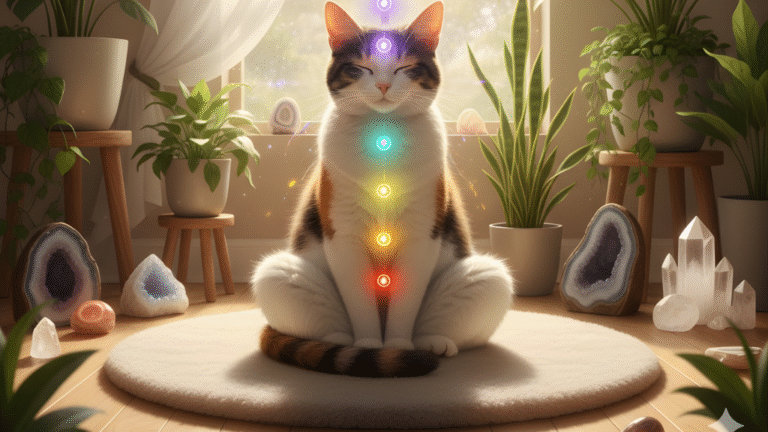Understanding The Basics Of Energy Healing For Pets
Energy healing for pets is becoming a meaningful part of holistic animal care, but for many pet parents, it still feels mysterious or hard to picture.
When people hear the phrase “energy healing,” they often assume it's something complicated or spiritual, but at its core, it's about supporting an animal’s natural ability to relax, rebalance, and heal.
Animals already understand energy far better than we do—they react to tone, mood, intention, and subtle signals every moment of the day.
Energy healing simply taps into that natural sensitivity and offers gentle support in a way that feels safe and comforting.
Whether you’re new to the concept or have been curious for a while, understanding the basics of energy healing for pets helps you make well-informed decisions about how to support your animal’s emotional and physical well-being.
Over the years, I’ve watched energy work help dogs settle after stressful events, support rescue animals through transitions, and even help senior pets find deeper relaxation when they need it most. When done with respect and sensitivity, energy healing becomes another loving tool in your pet-care toolbox.
What Energy Healing Really Means For Pets
Energy healing is based on the idea that living beings have an energetic field and that emotional or physical stress can create imbalances within that field.
When those imbalances deepen, pets may show signs of anxiety, tension, mood changes, restlessness, or discomfort. Energy healing aims to bring that system back into harmony through calm, mindful intention, either through light touch or by working slightly above the body.
It’s gentle, quiet, and completely non-invasive, which is why so many pets respond positively to it—even those who dislike traditional handling.
The most familiar form of energy healing is Reiki, a practice that originated in Japan more than a hundred years ago. Reiki focuses on creating balance, encouraging natural healing, and releasing stored stress.
When offered to animals, it adapts beautifully to their individual needs. Some pets prefer hands-on support, while others relax deeply when the practitioner works from a distance.
Unlike massage or physical therapy, energy healing doesn’t push, bend, or manipulate anything. Everything is guided by the animal’s comfort level and their willingness to participate.
Why Animals Respond So Naturally To Energy Work
Animals communicate energetically all the time. They read intention before body language and can sense calmness, tension, fear, or compassion within seconds.
When someone offers Reiki or another energy-healing method with a grounded, relaxed presence, pets instinctively notice and begin to soften.
Many practitioners start sessions by simply sitting quietly and waiting for the animal to approach or settle nearby. This approach respects their freedom of choice—something animals value greatly.
Energy healing also permits pets to rest. Many animals carry stress from past trauma, shelter experiences, changes in the home, or chronic conditions.
Because they can't explain what they feel, stress often shows up through behaviours like pacing, whining, hiding, restlessness, over-grooming, or clinginess. A calm energy-healing session signals to them that it’s safe to unwind.
I’ve watched anxious dogs fall asleep within minutes, shy cats slowly inch closer, and rescue animals who once avoided touch begin to relax around people again.
The Role Of Energy Healing In Holistic Pet Care
Energy healing isn’t meant to replace veterinary care—it’s a supportive practice that complements existing treatments. Many holistic veterinarians acknowledge that emotional well-being plays a large role in physical recovery.
Pets who experience less stress often heal faster, sleep better, and handle transitions with more ease. Energy healing can help during recovery from surgery, living with chronic pain, adjusting to new homes, or managing anxiety-based behaviours.
In shelters, rescues, and foster homes, Reiki is often used to help animals settle during one of the most stressful moments of their lives.
It creates a sense of peace during overwhelming changes. For senior pets, energy healing often brings comfort as their bodies age and mobility changes.
For highly sensitive animals, it becomes a way to ease daily overwhelm. Even healthy pets benefit because it reinforces a sense of safety and emotional grounding.
How Does Energy Healing Work? Looking At The Science
Many people ask whether energy healing is supported by science. Research is still developing, but the concepts stem from traditional Chinese medicine, Ayurveda, and modern biofield therapies.
These traditions view humans and animals as having energy systems that influence physical and emotional balance. When that system feels “off,” pets may show signs like anxiety, behavioural changes, or restlessness.
Some physical signs often linked to energy imbalance include nervous licking, tension, pacing, or sluggishness.
Studies in people have shown mixed but sometimes promising results — reduced anxiety, improved relaxation, and better overall well-being. You can find a scientific overview through the National Institutes of Health.
Animal-focused research is more limited, but there is a growing amount of real-world feedback from practitioners, shelters, and pet guardians who see improvements in calmness and comfort.
Because energy-based techniques are gentle and noninvasive, many pet owners use them alongside veterinary care to offer extra emotional support.
Popular Energy Healing Methods For Pets
Energy healing isn’t a one-size-fits-all approach. Just like people, animals respond differently depending on their personality, history, and level of sensitivity.
Over the years, a handful of methods have become especially popular because they’re gentle, simple, and adaptable to many situations.
Here are the most widely used energy-healing practices you’ll hear about — and how they support your pet’s emotional and physical well-being.
1. Reiki
Reiki is the most recognized form of animal energy healing. It uses calm presence, intention, and either light touch or completely hands-off techniques to support emotional balance and deep relaxation.
Pets who are anxious, recovering from trauma, or adjusting to new environments often respond exceptionally well. Reiki can also be used during illness, recovery, or simply as a comforting wellness practice.
What makes Reiki unique is that the animal leads the session. They choose how close they want to be, whether they prefer touch or distance work, and how long the session lasts.
2. Healing Touch For Animals
Healing Touch for Animals® uses slow, sweeping hand movements to balance the animal’s energy field. It’s often used during stressful transitions such as travel, new adoptions, vet appointments, or end-of-life care.
Practitioners may work around specific energy centres (chakras) or focus on helping the animal release tension in certain areas. Many pet owners describe their animals as appearing noticeably calmer after a session.
3. Acupressure
Acupressure is a needle-free version of acupuncture. Instead of using needles, the practitioner applies gentle finger pressure to specific points along the body’s meridians to support the pet’s natural energy flow.
Some benefits people report include:
-
Easing stiffness
-
Helping with digestion
-
Reducing anxiety
-
Supporting overall vitality
Because acupressure involves touch, it works best for animals who enjoy physical contact and are comfortable being handled.
4. Crystal Healing
Crystal healing is often used as a companion practice during moments of rest. Crystals are placed nearby — not on the animal — to create a soothing, grounded atmosphere.
While scientific evidence is limited, many pet owners feel crystals help with emotional balance, especially for sensitive or rescue animals. Common choices include amethyst, rose quartz, and black tourmaline.
The main goal here isn’t the crystal itself; it’s creating a peaceful, supportive environment where the animal feels safe to unwind.
5. Sound Therapy
Sound therapy uses calming music, singing bowls, or tuning forks to support relaxation. Many animals respond beautifully to steady, soothing frequencies — especially pets who dislike storms, fireworks, or loud households.
Music designed specifically for pets can help:
-
Reduce anxiety
-
Improve sleep
-
Support recovery from stressful events
-
Calm overstimulation
Some practitioners combine sound therapy with Reiki for an even deeper calming effect.
6. Aromatherapy & Flower Essences (With Caution)
Some pet owners explore aromatherapy or flower essences to help their animals relax. Essential oils must be used with extreme care — many are toxic to cats, birds, or small animals. Always consult a veterinarian first, and only use products made specifically for pets.
Flower essences, like Bach Flower Remedies, are gentler and often used to support emotional stress, fear, or behavioural imbalance. Again, each animal is different, so it’s best to introduce these gradually and observe how your pet responds.
7. La Trame
A lesser-known but increasingly respected technique, La Trame focuses on restoring harmony to the body’s energetic blueprint.
Practitioners use a precise sequence of light, rhythmic movements along the body (hands-on or hands-off) to release emotional blockages and improve overall flow.
Many pet owners say La Trame helps animals who carry old trauma, struggle with anxiety, or have difficulty settling emotionally.
Want to Share Your Love for Pet Reiki?
Discover how meaningful it can be to support animals through Reiki — and how to share that passion with others in a heart-centred way.
How To Send Healing Energy To Your Pet
You don’t need advanced training to offer calm, supportive energy to your pet. A quiet space, a relaxed mind, and kind intention make all the difference.
Here’s a simple process you can try at home:
- Choose a calm, familiar spot where your pet feels safe.
- Sit quietly nearby and take a few slow breaths to settle your own energy.
- Visualize warm, gentle light flowing toward your pet.
- Hold a loving intention, such as “May you feel calm and comforted.”
- Watch your pet’s body language and let them choose how close they want to be.
- Let the session last five to ten minutes or until your pet naturally moves away.
This practice can be used anytime — after a stressful vet visit, before bedtime, or whenever your pet seems out of sorts.
Over time, your pet may respond more quickly as they learn to associate your peaceful presence with comfort and safety.
How To Activate Healing Energy
Activating healing energy is really about mindfulness, breath, and gentle focus. You’re not performing magic — you’re offering calm, caring attention.
- Start with slow, deep breaths.
- Rub your hands together to bring awareness and warmth.
- Visualize soft light filling your hands.
- Hold a sincere intention to support your pet’s comfort.
- If you have learned methods like Reiki, use them; otherwise, trust your intuition.
There’s no “right” or “wrong” way to offer soothing presence. Follow your pet’s lead and adjust your approach based on what makes them feel safest.
How To Do Reiki On A Pet
Reiki is one of the simplest and most intuitive healing methods you can learn. While formal training is always helpful, many pet parents begin with books, videos, or gentle guidance from shelters and community practitioners. What matters most is your intention, your calm presence, and your willingness to let your pet lead the experience.
Here is a clearer, more supportive step-by-step guide:
1. Create A Calm Environment
Choose a space where your pet already feels safe — a favourite cushion, sunny window spot, or quiet corner. Keep lights soft and reduce noise where possible.
Allow your pet to move freely. They may settle down beside you, shift positions, or walk around. Reiki works beautifully even when animals are active; they’re simply regulating their comfort level.
2. Prepare Yourself First
Before offering Reiki, spend a moment settling your own energy. Sit comfortably, relax your shoulders, and take a few deep breaths. Animals instantly pick up on our emotional state. When you feel grounded and peaceful, your pet naturally relaxes too.
3. Set A Gentle Intention
Reiki doesn’t require force or concentration. A simple, loving intention is enough.
You might think quietly:
-
“May you feel calm and safe.”
-
“I’m here to support your healing.”
-
“I offer you comfort and peace.”
This intention helps guide the session without pressure or expectation.
4. Open Your Hands And Let Your Pet Decide
Start by placing your hands lightly on your pet or just above them. Some animals love touch; others prefer energy offered from a small distance.
A good approach is:
-
Hold your hands a few inches above your pet
-
Allow them to come closer if they want extra connection
-
Follow their body language instead of trying to control the moment
If your pet moves away, that doesn’t mean the session stops — it simply means they need space. Many animals relax more deeply when they’re given freedom.
5. Stay Present And Let The Energy Flow
Focus on quiet presence, soft breathing, and gentle awareness. You don’t need to “do” anything. If you know Reiki symbols, you can use them. If not, simple mindfulness is perfectly enough.
Signs your pet is benefiting include:
-
Slow blinking
-
Deep breathing
-
Yawning
-
Stretching
-
Curling up near your hands
Some animals even fall asleep, which is a wonderful response.
6. Close The Session Naturally
After a few minutes — or longer, if your pet stays engaged — slowly bring your hands back to your lap. Thank your pet with a kind word or gentle stroke (if they enjoy touch).
Let them transition however they choose — by stretching, wandering off, or continuing to rest. Reiki sessions do not need to be long; even five minutes can be meaningful.
Want To Learn More?
If you’d like to explore deeper training, the International Association of Reiki Professionals (IARP) and the International Center for Reiki Training (ICRT) offer excellent beginner-friendly resources on animal Reiki.
Practical Tips for Successful At-Home Energy Healing
1. Let Your Pet Choose
Animals respond best when they feel in control. Invite your pet into the session instead of guiding or positioning them. If they walk away, that’s perfectly fine — it simply means they’re not ready yet. Allowing freedom builds trust and strengthens their willingness to participate next time.
1. Pay Attention To The Body Language
Softening eyes, steady breathing, slow blinks, gentle stretching, or quiet purring/meowing are all signs your pet feels safe and receptive.
If you notice tension — such as tail flicks, lip licking, pinned ears, or restlessness — pause the session and give them space. These cues help you adjust the energy, distance, and length of the healing moment.
2. Keep Sessions Short
Short, simple sessions are often the most effective. Most pets benefit from five to ten minutes, especially when they’re just getting used to energy work. Ending sessions while your pet still feels comfortable helps them build positive associations over time.
3. Practice Regularly But Gently
Weekly consistency can make a big difference. Aim for one or two sessions a week, and let your pet guide you if they want more or less. Some pets will start seeking out Reiki or energy healing once they learn how calming it feels.
4. Combine With Vet Care
Energy healing is a supportive tool — not a replacement for professional veterinary care. Use it to complement your pet’s regular medical treatments, behavioural programs, or recovery routines. Always follow your veterinarian's advice if your pet has ongoing health concerns.
Frequently Asked Questions About Energy Healing For Pets
Q1: Can Anyone Try Energy Healing With Their Pet?
Yes. Many pet owners use simple techniques at home. Workshops and videos can help deepen your practice.
Q2: What Signs Show My Pet Is Receptive?
Relaxation. Look for sighing, blinking, stretching, or moving closer. Restlessness means it’s time to pause.
Q3: Should I Stop Veterinary Care?
No. Energy healing is a supportive practice, not a replacement for medical treatment.
Q4: How Often Can I Practice?
As often as it feels natural. A few times a week is a gentle starting point.
Q5: Can Reiki Help Aging Or Special-Needs Pets?
Yes. It can offer emotional comfort and relaxation, especially for senior pets or rescues, but it does not cure medical issues.
Energy Healing As Part Of Your Pet’s Overall Wellness
Energy healing is a meaningful way to support your pet’s well-being. It does not replace standard care, but it can ease stress, deepen your bond, and offer comfort during challenging times.
The best results come from patience, gentle intention, and listening closely to your pet's needs. Even if you're new to these techniques, exploring a few simple practices can make everyday life more peaceful for both you and your animal companion.
I trust you enjoyed this article on Understanding The Basics Of Energy Healing For Pets. Please stay tuned for more Reiki insights, pet wellness tips, and holistic lifestyle ideas.
Take care!
— JeannetteZ
💬 Your Opinion Is Important To Me
Do you have thoughts, ideas, or questions? I’d love to hear from you. Please leave your comments below or email me directly at Jeannette@pawreiki.com.
📚 More PawReiki Reads — Discover Energy Healing & Holistic Pet Wellness
💜 My #1 Recommendation for Online Success
Reiki has brought so much peace and purpose into my life. If you've ever dreamed of creating a gentle income stream around your love for animals and holistic healing, this platform gives you all the tools, training, and community support you need.
🌟 See How Reiki Lovers Build Online Income — Try WA Free
No credit card required · Free starter training included
Disclosure
This post may contain affiliate links. As an Amazon Associate and participant in other affiliate programs, I earn from qualifying purchases at no extra cost to you. Please read my full affiliate disclosure.







